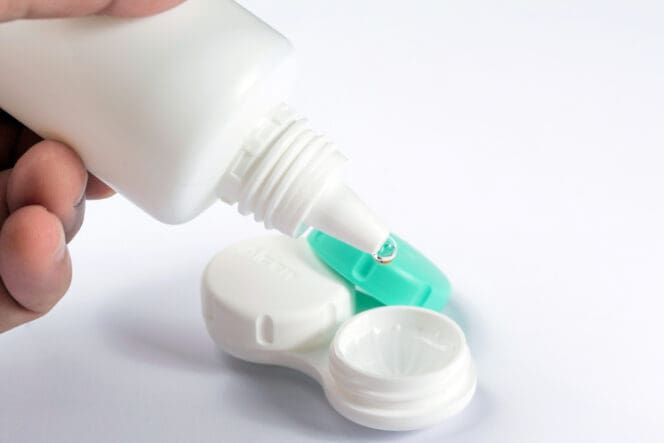Contact lens solution is a water-based product used to clean the lenses with the goal of extending their comfort and usefulness. Many manufacturers make a variety of solutions, which necessitates consumers do a little research to see what solution is best for their contacts.

Solutions can have specific applications. Learn what solution works best of your type of lenses.
Intro
Contact lens solution is a necessary part of proper contact lens maintenance, but it can be difficult to find the right product for you. With so many different types available in stores, how can you tell which is best?
Each contact solution is designed for specific applications. To find the best one for you, you will need to learn more about what each type has to offer and how each product matches up with your contact lenses.
Types of Contact Solutions
The three main types of contact solutions available are multipurpose contact lens solutions, hydrogen peroxide-based solutions and basic saline solutions. Each has a unique formulary and specific use.
Multipurpose Contact Lens Solution
Multipurpose contact lens solutions are very popular for their wide-ranging abilities and ease of use. They can be used to clean, rinse, disinfect and store contact lenses safely. This simplifies your contact care routine and allows you to use just one product for all of the necessary steps.
Hydrogen Peroxide-Based Solutions
Hydrogen peroxide-based solutions can also be used to soak or disinfect contact lenses. Solutions that contain 3 to 4 percent hydrogen peroxide will effectively break down germs and other contaminants on your lenses.
Before removing your lenses from a hydrogen peroxide-based solution, you will need to add a neutralizing agent to break the peroxide down into water and oxygen. Follow the instructions written on the product packaging to do this.
It is not safe for hydrogen peroxide to make contact with your eyes before it is neutralized. If you choose a hydrogen peroxide-based solution, always use as directed. Never use it to rinse your contact lenses or your eyes.
Basic Saline Solutions
Saline solutions are simple pH-balanced saltwater solutions that mimic natural tears. They may be used to rinse your lenses before you put them on. You can also store your contacts in saline solution overnight.
Saline solutions lack clinical-grade cleansing agents and should not be used to disinfect your contact lenses. Always use a proper disinfecting agent as part of your contact care regime to avoid eye infections.
Things to Consider When Choosing the Best Contact Solutions
The primary factors to consider when you are looking for the right contact solution are comfort, disinfectant potential and soaking and cleaning time.
Comfort
A contact solution can only function properly if it matches the pH of your body’s natural fluids. Solutions that meet this criterium help your eyes remain moist throughout the day by simulating natural tears, making them very comfortable and easy to wear.
Ophthalmologists recommend contact solutions that have a pH value of around 7.5 or better.
Disinfectant Potential
You also need to know how well a given contact solution can disinfect your lenses. All FDA-approved solutions meet the required disinfectant ability standards, so look for a solution has this approval.
Most off-brands do not have FDA approved, and you should not trust them to clean your lenses.
Soaking and Cleaning Time
When you shop for a new solution, check each solution’s required cleaning and soaking time. This affect a solution’s convenience and usability.
Multipurpose contact lens solutions require you to clean the lenses for 20 seconds, then submerge them in solution and soak them for four to eight hours.
Hydrogen peroxide solutions must be given enough time to neutralize before you remove the lenses from the solution. This usually takes at least six hours.
How To Choose the Right Contact Solution
To find the contact solution that is right for you:
- Speak with your eye doctor. They can offer you advice based on your individual eye health profile.
- Figure out how much money you have available to spend each month. If you don’t have the funds for a high-end solution, you’ll have to find a basic product that suits your needs.
- Check the label for ingredients that may affect you in a negative way. If you were previously using a contact solution that triggered allergic reactions, share this with the doctor. It is important to identify the ingredient that caused the problem and avoid using solutions that contain this ingredient in the future.
References
-
Contact Lenses. (March 2017). National Eye Institute.
-
Contact Lens Solutions and Products. (January 2018). U.S Drug and Food Administration.
Last Updated April 4, 2022
Note: This page should not serve as a substitute for professional medical advice from a doctor or specialist. Please review our about page for more information.